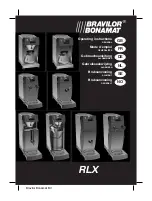
G I S C H A I N H O I S T S W I S S Q U A L I T Y
18
3.2.8 Suspension parts
3.3 Ordering spare parts
4 Measures for obtaining a
safe period of operation
4.1 Determining the actual
utilization period S
4.2 General overhaul
All statically loaded parts are considered suspension parts. The bearing surfaces of the
slewing suspension parts must be periodically greased.
Torque values for screws of property class 8.8 according to DIN ISO 898:
M 5
M 6
M 8
M 10
M 12
6 Nm
10 Nm
24 Nm
48 Nm
83 Nm
Information on how to order spare parts can be found on page 3.
The statutory and health requirements of the EU regulations stipulate that specific
dangers which may arise from fatigue or ageing must be prevented.
Accordingly, operators of standard hoist gear are obliged to determine the actual
utilization. The actual utilization period is determined and recorded as part of the annual
inspection by customer service engineers. A general overhaul must be carried out when
the theoretical utilization limit is reached, or after no more than 10 years.
All checking and the general overhaul itself must be arranged by the operator of the
hoist gear. The following theoretical utilization periods apply to electric chain hoists that
are categorized according to ISO 4301-1 (converted into full-load hours):
M3
M4
M5
M6
M7
400 h
800 h
1600 h
3200 h
6300 h
The actual utilization period depends on the daily operating time and the load collective.
Running time is determined from information provided by the operator or recorded using
a meter that counts the number of operating hours. The load collective is determined in
accordance with table 1-1, page 9. These two items of information are used to calculate
the annual utilization period from table 4-1.
If an operating data acquisition system (BDE) is used, the actual utilization can be read
out directly by our experts during the annual inspection.
CAUTION !
The values periodically calculated or read-off must be recorded in the log
book.
On reaching the theoretical service life (no later than 10 years for recording without
BDE), a general overhaul should be performed. This enables the equipment to continue
operating safely for a further period of utilization (service life). Components must be
inspected and/ or replaced in this overhaul according to table 4-2. Inspection and
approval for further use must be performed either by a specialist company authorized by
the manufacturer, or by the manufacturer personally.
The inspector determines: – the new theoretical utilization possible
– the maximum period until the next general overhaul
This data should be recorded in the log book.
Table 4-1 Annual service life
Utilization
per day [h]
<= 0.25
(0.16)
<= 0.50
(0.32)
<= 1.0
(0.64)
<= 2.0
(1.28)
<= 4.0
(2.56)
<= 8.0
(5.12)
<= 16.0
(10.24)
> 16.0
(20.48)
Load
collective
Annual service life [h]
k = 0.50
6
12
24
48
96
192
384
768
k = 0.63
12
24
48
96
192
384
768
1536
k = 0.80
24
48
96
192
384
768
1536
3072
k = 1.00
48
96
192
384
768
1536
3072
6144
Table 4-2 General overhaul
Components of GCH-models
all types
Check for wear *
Replace
Brake x
Motor shaft
x
Gear teeth
x
Antifriction bearing
x
Washers
x
Chain x
**
Chain wheel, chain guide
x
Deflection wheels
x
Suspension x
Load hook
x
Travelling gear, running wheel
x
Contactor, limit switch
x
* replace when worn
** replace no later than at general overhaul





































